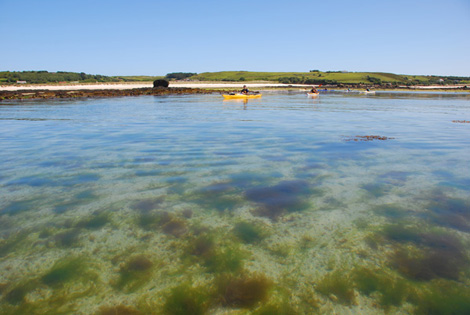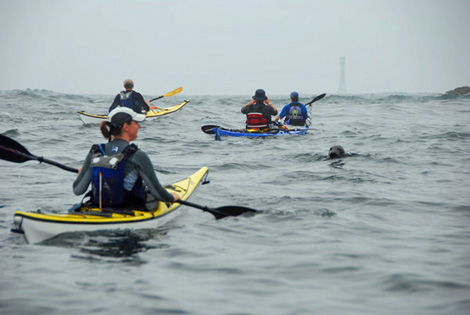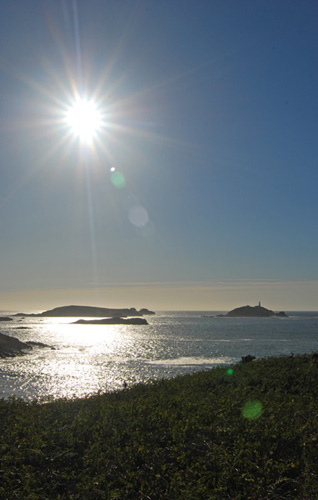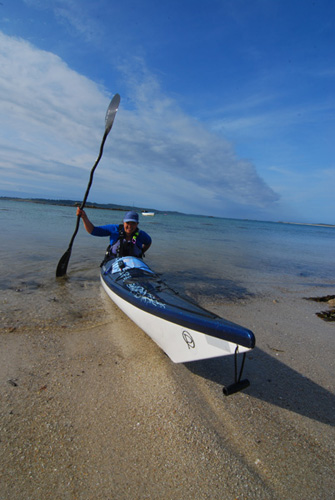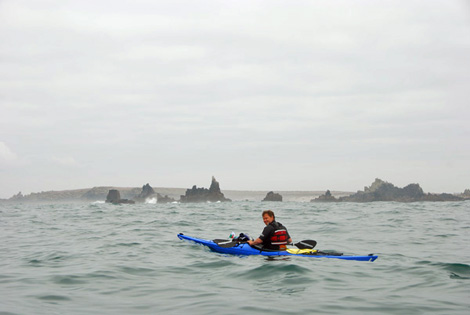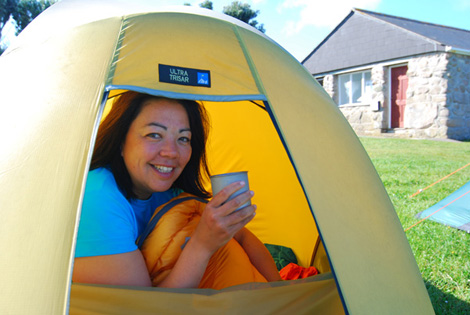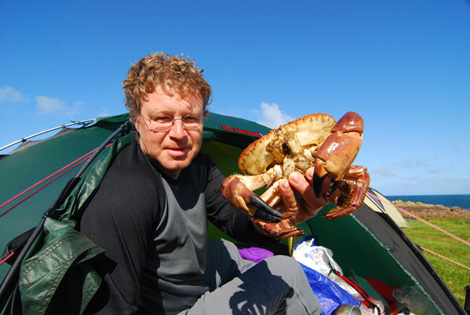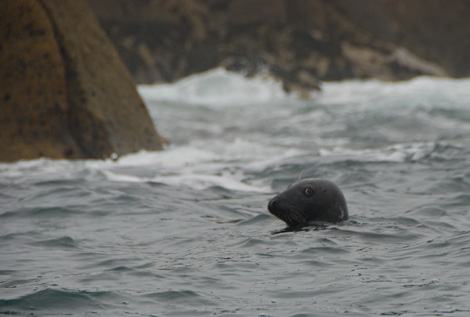motion A few months back, I was asked by Canoe Kayak UK magazine to pen an article on how to plan and carry out a multi-day trip, for their special sea kayaking supplement. I’m not a coach these days and I don’t tend to write technique/nutsnbolts stuff too often, but I enjoyed putting this together and I hope it makes some sense, at least. It’s primarily aimed at paddlers who ‘follow the herd’ and only go on trips with their club or commercial centres; if it persuades one such paddler to think independently and carry out their own adventures, it’ll have been worth writing. You now own a sea kayak. You’ve paddled along the coast on day trips and you’re learning about navigation, tides and weather. As each trip ends, you’ve wondered what it might be like to paddle on a little bit further. You’ve gazed at the sinuously upturned bow of your kayak and realised that this is a craft that wants to travel, to explore, to seek out new lands and *ahem!* to boldly go where no man has gone before. The BCU Sea Touring Committee describe sea kayaking as, ‘A special kind of freedom’ and that perfectly sums up what you are yearning for; rugged coasts, wild camps and the sense of journeying, fettered only by tide and weather. It’s time to make a multi-day trip. Now that you have the urge, what do you do with it? Tagging along with an experienced group or local club is a reassuring option for a first trip. So is paying out to join a trip run by an established outdoor centre or coach. These options will relieve you of the burden of planning and decision-making, and may helpfully allow you to borrow or sample some of the gear needed. Sooner or later you’ll want to do your own thing and make your own voyages of discovery; independence and freedom are what sea kayaking is all about. This article will hopefully get you started. Disclaimer: although he’s been around a bit, this author has no formal coaching qualifications. Judge his advice for yourself in the following article and allow for the possibility that he has no idea at all what he’s talking about. The group Although this is a no-brainer for most paddlers – you’ll want to paddle with your usual friends, or partner, or club – you should certainly give some thought to group dynamics. A trip is much more likely to be a success if everyone involved wants the same thing from it and has the same aspirations. Hence, an honest discussion beforehand is time well spent. How far do you all wish to paddle? What kind of conditions are you happy with? Are you all content to paddle at the speed of the slowest? Unfortunately, an uneasy group compromise is a recipe for both social disaster (everyone falling out) and literal disaster (involving rescue services!). Also, be honest in assessing whether each paddler will be a positive and helpful team member or a PITA (it’s an acronym). The size of the group will influence the outcome of your trip. Regard
three paddlers as a safe minimum (if you have the skills and experience
to paddle with less, you’ll already know). Large groups are great fun
around camp and make for a sociable trip. On and off the water however,
they are slow and difficult to keep co-ordinated. As a rule of thumb,
assume that every additional paddler beyond three will markedly reduce
what you’ll achieve during your trip, and that beyond eight paddlers,
the group will become increasingly unworkable. It’s no coincidence that
most major sea kayak expeditions have been carried out by solo paddlers.
The challenge is to find a happy middle ground between such single-minded
misanthropy and a dysfunctional mob. Another factor to consider is the
environmental impact of your group size. Larger groups are less likely
to encounter wildlife close up and will not be suited to sensitive,
delicate camping locations.
Does your group require a ‘leader’? This is a hot topic but basically, the answer is probably ‘yes’ and if you’re reading this article seriously, then it’s probably you. The degree of formality or informality in this arrangement is for you to establish with your paddling peers. Planning the route Sea kayakers the world over dream of visiting our shores! Yes, the best place to do your first multi-day trip is the UK, and arguably it’s best for every trip afterwards! The undisputed highlights are the west coast and islands of Scotland, but no part of our coast is without merit*. To help you choose where, there are worse starting points than a road atlas. The kind of multi-day trip you wish to make will influence your choice of area. Sections of coast facing the open ocean will be exposed to swell and surf. Open water crossings of more than 3-4 miles should be avoided unless you already know better. Clusters of islands or sea lochs offer plenty of route choice and flexibility, if the weather changes. Large islands offer great opportunities for circumnavigation trips returning to your start point, but tie you to paddling in one direction. Similarly, a simple ‘A to B’ coastal trip can be tricky to achieve as you are dependent on the weather suiting your direction of travel for the duration. Pore over OS maps to get a detailed idea of what you will encounter.
Prominent headlands and narrow straits may indicate tide races. Long
sections of cliff will mean no landing zones. Long straight beaches
are more likely to be ‘closed out’ by surf than bays and inlets. Pebble
beaches shelve more steeply than sandy ones, creating dumping waves.
Large settlements will make discreet camping tricky. Large areas of
tidal shallows and mud flats should be avoided like the plague!
Nautical charts look the part, but rarely contain much information of direct use to kayakers. Pilot books (www.imray.com), tidal atlases and sea kayak guidebooks (www.pesdapress.com) will give specific tidal information and www.easytide.co.uk is a simple and free way of gauging the tidal strength in an area; look at the ‘springs’ tidal range. How far can you go? Plan conservatively, especially with a large group. Assume 3 miles an hour as a maximum pace for a group with loaded boats, not factoring in exploring caves, rockhopping and chocolate stops. Covering 10-15 miles each day is a good target. If you can all go much further and faster, you’ll already know. How long for? It makes sense to first practice with a single overnight camp on local waters, but five days to a week gives time for a satisfying multi-day trip. If you enjoy that, anything is then possible, as long as you can resupply with food every week or three; Paul Caffyn spent a year circumnavigating Australia! Oddly, long trips can feel easier logistically than short trips. You often lug the same amount of gear along on a weekend trip as you would on a longer trip, and it can be a few days into a trip before camping and packing arrangements become a faff-free routine. When to go? If you are able to be flexible, wait for a long-range forecast of high pressure, settled weather and light winds. Depending upon your group’s competence with rough water, you may also wish to plan your trip a few days either side of ‘neap’ tides – when the tide flows most slowly. With an idea of the journey that you want to make, consider how flexible your plan is. If the wind strengthens or surf builds, what are your options? Do you have a sheltered alternative route? Are there spots where you could be stuck ashore? Is there road access where you can abandon your trip? Can you get back to the car? Do you have a back-up plan if you arrive and decide that your original route isn’t a good idea? * Excluding Chesil Beach. On the water It isn’t the purpose of this article to instruct paddlers how to actually paddle, but consideration needs to be given to how your multi-day trip will look out on the water. Actually, what happens on the water is predominantly determined by
what you do before you launch. Prior planning based on good judgement
is everything, because once you’ve launched, your options are massively
reduced. • Most importantly, check the weather forecast, carefully consider its implications and if in any doubt, change your plans. Force 4 winds will impede progress and whip up waves, Force 5 may cause serious problems. Avoid anything stronger unless you are sure you know better. The direction of the wind is also important. Offshore winds are dangerous, meaning temptingly smooth seas beside your launch spot, but rougher water the further out you are blown. Winds blowing in your direction of travel sound appealing, but are actually the trickiest to control a kayak’s direction in. Any forecast of poor visibility (i.e. fog) should also cause concern. • Look carefully at the local conditions and sea state. If it doesn’t look good, then it isn’t. Any surf breaking ashore needs consideration; are you competent to get out through it? What effect will this swell have on headlands, cliffs and tide races along your route? What will it make landing like? Note that groundswell can often be several times taller offshore than the beach break. • Check the tide flows and plan to launch at a time that will allow you to utilise (or avoid) their power. Avoid ‘wind against tide’, where the tide is flowing in one direction and the wind is blowing against it; this generates steep, choppy or even breaking waves. • Plan out your intended route, factoring in the weather, tide, landing zones, escape routes and suchlike. Check that map, compass, tidal notes and watch (and GPS?) are easily accessible. • Check over the safety and communication gear that you will of course be carrying. Items such as distress flares, towlines, pumps, mobile phone, VHF, etc should be safely secured but easily available to hand. • Contact the Coastguard via mobile phone or VHF radio (Channel 16). Tell them your plans and call them afterwards when you are safely ashore. Incidentally, they won’t take action if you do not call again; it is good practice to have a third party (friend/relative at home?) who will call them if they don’t hear from you. • Ensure that all of the above is communicated amongst and understood by all of the group. If the steps above have been faithfully adhered to before launching,
the odds of a problem developing out on the water will be vastly reduced.
All of this leaves you free to do what you came to do, which is to enjoy
and explore our fantastic coastal environment. Navigating should not
be a huge problem if you planned properly beforehand. It makes sense
for everyone to have a map and compass and know where they are going,
why hog the navigation?
Group dynamics on the water need consideration; a group spread all over the place each doing their own thing is not a group, and obviously problems may arise. A group leader who has issued clear instructions and expectations is one solution to keeping everyone on track, but it’s equally desirable for everyone in the group to act responsibly. Coaching types use the acronym CLAP to outline effective leadership, but the principles that it embodies should be understood and followed by all paddlers in a group… • Communication. Let people know what’s going on, stay in touch with them. • Line of sight. You should always be in a position to monitor what your fellow paddlers are up to. This can’t be achieved over the horizon! • Avoidance is the best form of prevention. In other words, best not do anything that’ll require undoing. • Position of most usefulness. Always be looking out for, and jostling to achieve, the spot within the group where you are best able to keep track of what is happening and most prepared to respond accordingly.
Camping Coming ashore and setting up camp after a day on the water is wonderful. With the tents up and a (hopefully) delicious meal served, the day’s adventures can be reviewed over a beer. Everyone has their own personal approach to camping, but a few pointers follow. Firstly, your camping gear all has to fit in the boat. Packing used to be a form of purgatory but modern sea kayaks have big hatches making it easy to pack and retrieve your gear. That said, it can be a day or two before you figure out the best system for slotting it all in. Good dry bags are cheap and easy to get (e.g. www.ewetsuits.co.uk). We tend to bag up gear together based on categories like… • Kitchen (food, stove, fuel, matches, plates and cutlery) • Bathroom (toiletries, loo paper) • Wardrobe (dry clothes) • Bedroom (tent, Thermarests, sleeping bags) …but then again, we are very dull people. Other gear? You’ll need fresh water, which can be carried in expensive Ortlieb waterbags or big supermarket bottles. This can be replenished from taps, or (less appealingly) from purified stream water. A large drybag/rucksack is indispensible when you are shifting your gear from kayak to camp spot. A trolley may be useful if you have to move the boat any distance. A LW radio is indispensible for getting the forecast and a good book will keep you sane if the weather forces you to be stormbound for a day or two. In Scotland, a midge hood is an unfortunate necessity. Where to camp? The spot you select is your call, but try to be discreet and steer away from people’s houses and gardens. In Scotland there are few legal strictures on responsible groups, but in England and Wales the law is hazier; hence it’s often appropriate to keep the number of tents to a minimum, arriving late and leaving early. In some locations, there are of course ‘proper’ campsites near the water.
Which tent? Tents come in all shapes and sizes, but something with decent porch space is ideal for cooking in wet weather. A freestanding tent will allow you to camp on the beach, but note that sand gets everywhere! What’s cooking? We cook on a Trangia stove with a gas attachment; stable,
simple, safe. What you eat for dinner is down to you, but the amount
of space available in a sea kayak means that Vesta Dried Curry is never
forgivable. Think carefully before you start a fire; is it necessary
and appropriate? If you convince yourself that the answer to both questions
is yes, then light it on the beach in the inter-tidal zone and remove
all trace afterwards.
Where’s the loo? Do your business well away from camp, between the high and low tide mark. Burn paper and bury everything. Some paddlers carry out all waste in tubes. Alternatively, wait for or walk to a public toilet. Ray Mears/Bear Grylls-style survival isn’t for everyone. There is no reason at all why you can’t indulge in ‘credit card’ sea kayaking, where you stroll to a pub for lunch in the evening, and perhaps sleep the occasional night in a seaside Bed and Breakfast. Such luxuries are rarely far away in the UK, and sea kayaking is a broad church! End note Skimming back over this article, it looks as exciting as a telephone directory. Tedious lists of ‘don’ts’ and equipment inventories. Yawn. Please don’t lose sight of the wood for the trees, though. This dull but necessary information is a stepping stone to help you reach the real goal. You’ll know you’ve achieved it, when you first watch the sun melt into the sea from your tent, or when you realise that you’ve crossed the mornings’ horizon, or when you become reconciled to the weather and tide dictating your days. That’s when you’ll know that you enjoy a special kind of freedom. Further Reading and Information www.ukseakayakguidebook.co.uk
– contains masses of useful information and advice; look at the ‘Almanac’
and ‘Community’ sections.
Mark Rainsley - 2008 |
